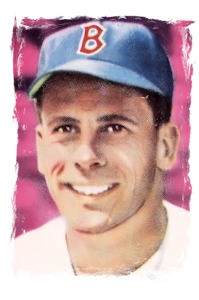 |
Randy Gumpert was born on January 23, 1918 in Monocacy, Pennsylvania. He attended Birdsboro High School, where he gained a reputation for his pitching. In 1934 his father wrote a letter to Philadelphia Athletics manager Connie Mack, suggesting the Athletics give his sixteen-year-old son a tryout. Mack liked what he saw and offered Randy a low-paying job throwing batting practice, which he did that year and the next after school had let out. In 1936, two weeks after his high school graduation, he signed a $300-a-month contract with the Athletics and made his Major League debut in June. He made twenty-two appearances in that 1936 season, nineteen of them in relief. In 1937 the Athletics tried to change his pitching style from a three-quarters delivery to overhand, but he injured his arm in the process. He spent most of 1937 and 1938 recuperating in the minors and made just fourteen big-league appearances in those two seasons. He went 13-10 for the 1938 Williamsport (Pennsylvania) Grays, earning an “honorable mention” all-star selection for the Eastern League. He began the 1939 season with the Class B Norfolk (Virginia) Tars, pitched well enough to jump up to the Class Double-A Baltimore Orioles, was then sent back down to Williamsport, and in July was sent to the Yankees system. The Yankees kept him in the Eastern League, assigning him to the Binghamton (New York) Triplets. He spent nearly all of 1940 in Binghamton, before moving up to the Newark Bears for one game. Randy continued to bounce around the Minor Leagues in 1941 and 1942, pitching for Newark, the Little Rock (Arkansas) Travelers, and the Kansas City Blues. But the war was on, and he enlisted in the Coast Guard and was based in New London, Connecticut, during much of his enlistment, playing baseball there along with other professional players to entertain his fellow Coast Guard members. After the war, he had a strong spring training in 1946 and returned with the Yankees to New York. After his disappointing 1947 season, made worse by the elbow injury, he went to training camp in 1948 with diminished expectations. He made the team and pitched well—a 2.88 ERA. In July 1948, Randy was sold to the White Sox, where he was inserted into their starting rotation. He went just 2-6 for the eighth-place White Sox, with a 3.79 ERA. The White Sox were counting on him in 1949, and he came through with a solid season. Unfortunately, for Randy and the White Sox, he could not build on that solid season. Used more as a reliever than a starter in 1950, and could manage no better than a 5-12 record. The 1951 season brought the then thirty-three-year-old’s greatest individual honor and his greatest claim to fame. In May, 1951, at Comiskey Park, he served up Mickey Mantle’s 1st major league home run. Randy also made the All-Star team for the only time in his career. In November 1951, the White Sox traded him to the Boston Red Sox. He appeared in only ten games for the Red Sox before being traded, in June 1952, to the Senators. His combined record for 1952 was 5-9 with a 4.22 ERA in thirteen starts. His last appearance was at Philadelphia’s Shibe Park, where he pitched two innings in relief against the Athletics. The Senators did not re-sign him for the 1953 season, so he headed west, playing two seasons for the Los Angeles Angels of the Pacific Coast League. His pitching career ended in 1955 with the Charleston (West Virginia) Senators of the American Association. At the age of thirty-eight, with his playing career behind him, Randy became a minor league manager. He split the 1956 season between the Bradford (Pennsylvania) Yankees of the Pennsylvania-Ontario-New York League and the Kearney (Nebraska) Yankees of the newly formed Nebraska State League. He managed at Kearney again in 1957 and 1958 and served as a part-time manager for the St. Petersburg Saints of the Florida State League in 1960. He had returned briefly to the Yankees in 1957 filling in for Coach Bill Dickey, who had to leave the club for health reasons. And in 1959 and other years, Casey Stengel invited him to be part of a pre-spring training “instructional school” for the Yankees’ top Minor League prospects. In 1961 he became a full-time scout for the Yankees. Around 1974, he joined the newly-formed Major League Scouting Bureau, a central scouting organization run by the Major League teams and remained a member of the bureau until he retired in 1993. Randy Gumpert enjoyed his retirement years and was honored in many local “halls of fame,” including the Pennsylvania Sports Hall of Fame, the Berks County Sports Hall of Fame, the Reading Phillies Hall of Fame, the Daniel Boone (successor to Birdsboro High) Hall of Fame, and the Major League Scouting Hall of Fame. Shortly after his ninetieth birthday, he moved from his Monocacy home to an assisted living center, where he died ten months later, on November 25, 2008, at the age of 90 years old. |
|||||
